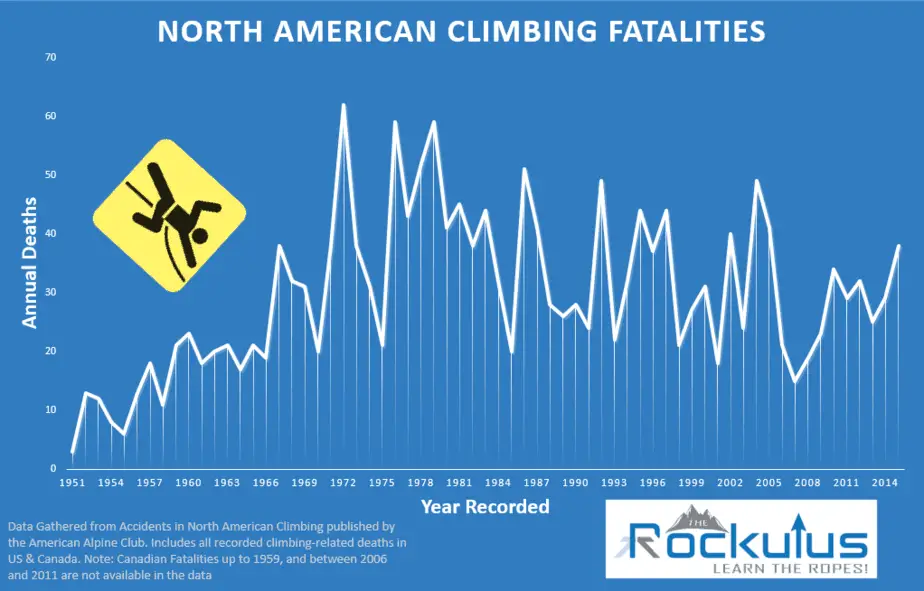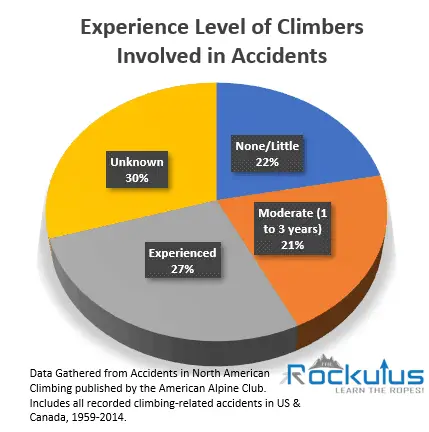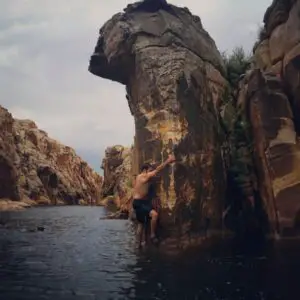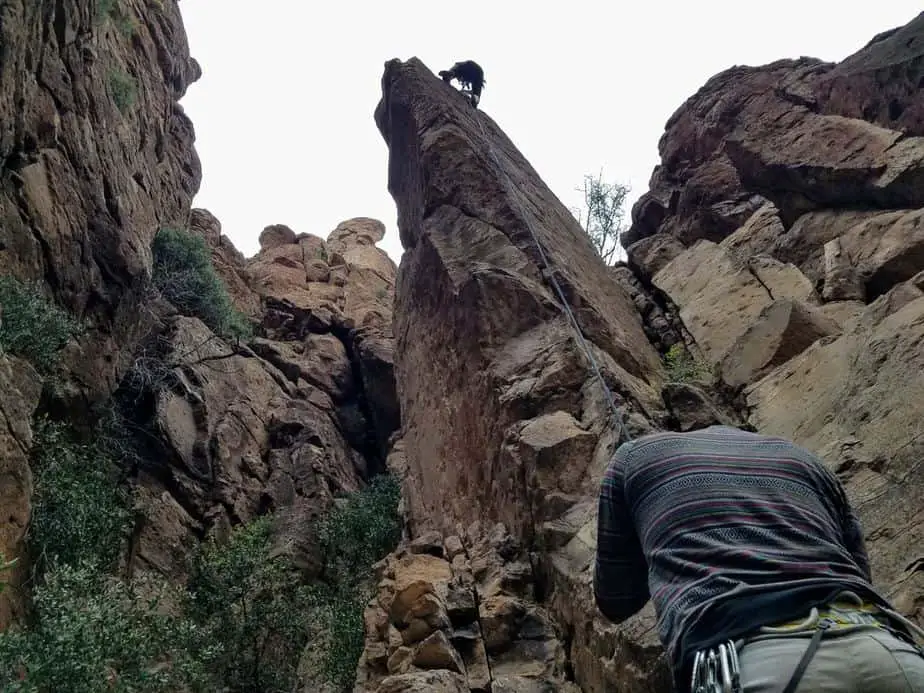When you tell someone that you’re going rock climbing, odds are they’re going to say something like “oh, I’d be too scared to do that.” The idea that climbing is wildly dangerous and full of adrenaline-addicted risk takers is pretty common. Representations in popular media, as well as the well-publicized occasional accident or death gain a lot of attention. How dangerous is Rock Climbing really?
On average, we see about 30 deaths per year, though it does fluctuate. Extrapolating 30 deaths per 5,000,000 North American Climbers to the estimated global total of 25,000,000 climbers, we could see around 150 climbing-related deaths per year. A 2017 report recorded 38 climbing-related deaths in North America in the previous year.
recorded 38 climbing-related deaths in North America in the previous year.
Due to inherent self-reporting bias, and limited reporting outside of the United States and Canada, this is the best information that is available. Note that this includes all types of climbing (ice, rock, mountain).

So the question becomes, is that a lot? What does that mean in terms of safety?
If you’re interested in the essential gear that’s required for rock climbing, check it out here .
.
Is Rock Climbing Dangerous?
Whenever someone dies rock climbing, the media can’t get enough of it- and I guess that’s because the public eats it up too. Accidents and deaths in less conspicuous activities don’t get the same amount of coverage. They are so rare that the occasional death always makes the news.
Due to the public’s interest in climbing accidents, media outlets promote these kinds of stories over stories of successful expeditions or everyday climbs. This leads to the commonly-held idea that rock climbing is dangerous.
Rock climbing is rapidly growing in popularity. According to the IFSC , 25 million people climb on a regular basis worldwide. The Outdoor Industry Association’s US-based 2018 Outdoor Participation Report
, 25 million people climb on a regular basis worldwide. The Outdoor Industry Association’s US-based 2018 Outdoor Participation Report shows that 5 million people climbed indoors in 2017, 2.1 million participated in sport climbing, and 2.5 million did trad, ice, or mountaineering (with overlap between types of climbing).
shows that 5 million people climbed indoors in 2017, 2.1 million participated in sport climbing, and 2.5 million did trad, ice, or mountaineering (with overlap between types of climbing).
At around 30 reported fatalities out of 5 million regular climbers in North America, the statistics are pretty clear. Rock climbing has a very, very low fatality rate. For safer styles of climbing , like sport climbing, bouldering, and gym climbing, the risk is reduced even further. Obviously, even one fatality is too many- especially in a close group like the climbing community; however, the odds of it happening to you are very low.
, like sport climbing, bouldering, and gym climbing, the risk is reduced even further. Obviously, even one fatality is too many- especially in a close group like the climbing community; however, the odds of it happening to you are very low.

How Dangerous is Rock Climbing Compared to Other Activities?
Let’s put that in perspective with another activity that has a terrible public reputation for safety- skydiving. According to the United States Parachute Association , the fatality rate is around 20 out of 3 million jumps. That’s pretty similar to rock climbing, but still is very small.
, the fatality rate is around 20 out of 3 million jumps. That’s pretty similar to rock climbing, but still is very small.
While the comparisons aren’t exact, there were 11.4 fatal car crashes per 100,000 people in the US in 2017. I’ve included really interesting infographic at the bottom of the article that shows fatality rates for popular activities and regular things.
in the US in 2017. I’ve included really interesting infographic at the bottom of the article that shows fatality rates for popular activities and regular things.
Even with a low fatality rate in rock climbing, accidents still do happen occasionally. A small oversight or lapse in attention 30 meters above the ground makes for a potentially fatal fall. At the end of the day, there’s no surprise- rock climbing is dangerous.
Mountaineering, ice climbing, and trad climbing involve a lot higher risk (oh, and Free Soloing ). Routes are often more remote, which means rescue will take a lot longer.
). Routes are often more remote, which means rescue will take a lot longer.
The remoteness means that there could be a lot more exposure to the elements- especially in freezing temperatures at high elevations. Storms blow in and can cause disasters at a moment’s notice.
Whenever a climbing death occurs, everyone does a postmortem analysis and determines in 20-20 what the victim may have been doing wrong that caused the accident. We wonder if anything could have been done differently, and make a resolution that we will never fall prey to the same mistake. More often than not, it seems, fatalities could be avoided by using stopper knots and double-checking knots.
The Myth of Gear Failure
One of the most common misconceptions by non-climbers is that of gear failure. Hanging on a cliff by nothing but a rope and harness may not seem very safe, but climbing gear can take a lot of abuse. For example, carabiners for climbing need to be rated at at least 20kn (kilonewtons). 1kn is about 225lbs (102kg).
need to be rated at at least 20kn (kilonewtons). 1kn is about 225lbs (102kg).
We wrote a full article about the amazing strength of quickdraws. According to the UIAA, climbing falls usually only generate up to 5kn. As long as you are using material specifically tested and rated for rock climbing, gear won’t fail.
about the amazing strength of quickdraws. According to the UIAA, climbing falls usually only generate up to 5kn. As long as you are using material specifically tested and rated for rock climbing, gear won’t fail.

Climbing ropes are usually good for about 5 significant lead falls before they should be retired. Depending on your climbing style, this could be every few months, or every few years. Check out our Rope Guide for more information on how to care for ropes and when to replace them.
for more information on how to care for ropes and when to replace them.
You can tell if something is rated for climbing because of the industry certifications stamped on it. Carabiners and ropes will have either “CE” and/or “UIAA” stamped on them, certifying that they have met stringent standards required for climbing gear. For more information on gear safety, check out the UIAA’s website .
.
Gear doesn’t fail, as long as it is used correctly. Gear failures would be catastrophic for any climbing company, and would almost certainly lead to lawsuits and bankruptcy. The risk of letting bad gear get out is too great to let happen from a financial and moral standpoint. When accidents happen, they happen due to user error or freak accidents like rockfall or lightening strikes.
How Safe is Indoor Climbing?
I wrote an entire article about the safety of Indoor Rock Climbing , but in summary, it is EXTREMELY safe. There are only 4 fatalities total that I’m aware of since they first started springing up around the world in the 1980’s.
, but in summary, it is EXTREMELY safe. There are only 4 fatalities total that I’m aware of since they first started springing up around the world in the 1980’s.
With the growth of the sport indoors, we can expect to see more fatalities over time just due to pre-existing conditions like heart attacks. A death due to equipment failure would effectively shut down a gym, so you can bet that gyms will do a good job of regular maintenance.

How Does Climbing Experience Relate to Accidents?
If you are looking to try out rock climbing, you may think that new climbers are a lot more likely to get hurt. The data actually shows that accidents can happen to climbers of all abilities and levels of experience. The accidents occur when climbers and belayers are careless.
It is extremely important that you learn from reputable sources, and take classes whenever possible. Rock climbing, when practiced correctly, is very safe. My guess based on my experience is that complacency, as well as attempts at more difficult conditions, lead to the same accident rates at higher experience levels.
The Data- Accidents in North American Climbing
Recording the number of deaths from climbing around the world is very difficult. The best resource I’m aware of is the American Alpine Club’s Accidents in North American Climbing  report, published each year.
report, published each year.
Accidents are self-reported, which certainly means the information is less than perfect. However, it’s the best information we have, and the AAC does a great service by publishing it. Note: the annual report was previously titled Accidents in North American Mountaineering until 2015.
The purpose for making all of this information available is to highlight the specific areas of risk that are most accident-prone. The hope is that climbers will learn from other’s mistakes, and won’t be doomed to repeat them. Unfortunately, the same motifs recur every year. There are lots and lots of rappelling accidents, and the vast majority could be avoided by simply paying closer attention and double-checking the system.
Danger of Types of Rock Climbing
Certain styles of rock climbing are more dangerous than others. Climbing is comprised of many different sub-styles that can vary greatly. Some are practiced in warm weather, some in cold. Some are practiced in remote areas, some in cities.
They range in height from small boulders to enormous mountains. The following list is of popular climbing styles in order of safety, in regular conditions.
Very Safe-
- Bouldering- Indoors is probably the safest climbing style, as long as you know how to fall correctly and no one goes underneath you. Outdoors is safe up to reasonable heights with ample crash pads and spotters.
- Top Rope Climbing- The main risk is in falling while rigging the rope at the beginning of the climb or in very poor belaying. Obviously, climbing indoors is even safer than outdoors.

Medium Safe-
- Sport Climbing- With lead climbing, you’re likely to take a fall. If you don’t fall, you aren’t trying hard enough! As long as routes don’t run out too far between bolts and belayers are capable, you shouldn’t have any severe injuries. Take special care when rappelling from the top of a route.
- Deep Water Soloing- Clearly, this depends on the situation. Most of us aren’t soloing 20 meters above the water though, so it’s pretty safe. The main risk would be an unplanned fall and any underwater hazards.
Medium Danger-
- Traditional (Trad) Climbing- A lot of us trad climb, but it is definitely more dangerous than sport climbing. The odds of a cam or nut popping during a lead fall are much higher than the odds of a quickdraw or bolt coming out.
- Big Wall and Multipitch- The farther you are from civilization and rescue, the more dangerous it gets. Weather, rockfall, and exposure can happen in an instant. While falling at a regular crag may only break bones, falling from a big wall will almost certainly be fatal.
Stupid (in my opinion)
- High Ball Bouldering- Bouldering outdoors above about 10 meters is extremely dangerous. A spotter may catch your head, but that’s about it.
- Free Soloing- Climbing without ropes- this is kind of a no-brainer (you won’t have a brain if you fall while free-soloing). It’s supposedly a great way to reach nirvana though (or heaven/hell if you fall).
Many climbing accidents actually happen on the rappel. This may be because the climber is anxious to get back to the ground, or because the climber is momentarily ‘off belay’ and off rope. It could also be that we overlook the rappel because of our intense focus on getting to the top.
No matter what it is, rappelling is often recognized as the most dangerous part of rock climbing. The 2018 accident report actually begins with a plea for all climbers to improve communication with the belayer, tie a stopper knot, and weight test the system before disconnecting from the anchors.
Ice climbing and mountaineering fall somewhere between medium danger and stupid on my very scientific scale above. They can be practiced by experts who are following every safety procedure, but mother nature can have a different plan.
5 Tips for Safer Rock Climbing
- Learn from reputable sources and keep up on your knowledge. Your local climbing gym probably offers courses, as do groups like Outward Bound
 . Just because someone who taught you has been climbing for a long time, doesn’t necessarily mean they’re an expert. Standards and procedures have changed over the years.
. Just because someone who taught you has been climbing for a long time, doesn’t necessarily mean they’re an expert. Standards and procedures have changed over the years. - Always wear a helmet. You never know when a climber will dislodge a rock down onto a belayer, or if a fall will swing your head into a wall. Rocks are harder than your skull, I promise.
- Double check your knots. Check that your harness is secure, and that your knots are tight. Then have your partner check you. Then do it again. This simple act would save lives every year.
- Practice safe rappelling. A disproportionate amount of climbing accidents happen on the rappel. Test anchors before committing to them, and test your knots as well. Brush up on your rappelling skills in this article
 .
. - Use a stopper knot. Guidebooks and area beta are difficult to follow, and nobody actually measures the height of a route. Tie a stopper knot in the ends of the rope so your belayer doesn’t accidentally drop you while lowering if the route happens to be longer than you anticipated. The same thing applies for rappelling.
Chances of Dying in Extreme Sports versus Everyday Activities
I can’t verify the accuracy of the statistics, but it sure is fun to look at.

From: Best Health Care Degrees

